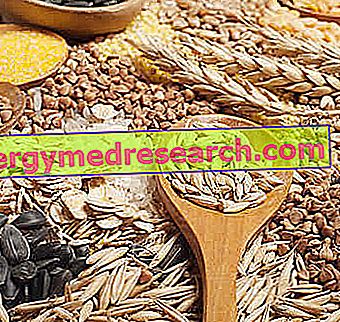Banana: introduction
Probably, the origin of the term "banana" refers to the Arabic banan, that is finger: just for this translation, in the contemporary age, bananas are commonly called also "fingers".

Fruit, leaves, flowers and seeds
The banana represents the fruit originated from the banana tree : more precisely, it is called apirene fruit of the same plant, being this devoid of seeds.

The leaves develop in the upper part, ending in a sort of crown; at the center of the leaves grow flowers, often characterized by very large bracts (improperly called petals) of violet color.
Bananas are the apyrene berries, seedless fruits with yellow skin and white and fleshy pulp: the black dots visible inside the pulp are the remains of the seeds .
Bananas grow in bunches, called helmets, sometimes consisting of over 200 bananas, which can weigh an overall 30 or 50 kilos.
Bananas: nutritional composition
Each single banana weighs about 150 grams, of which 75% is water and the remaining 25% is dry matter (carbohydrates, proteins, fats and fiber).
The banana fruit also represents a mine of vitamins and minerals: pro-vitamin A (beta-carotene), vitamins of the B group (in particular vitamin B1, B2, B3 - also known as vitamin PP) and vitamin C. Among the vitamins can not miss the vitamin E, although it presents in small quantities, and vitamin B6, also present only in traces.
Calcium, phosphorus, iron and potassium represent four classes of trace elements contained in the fruit, but potassium is certainly the most common mineral: so much so that bananas are also considered slightly radioactive, much more than other fruits are ( there is a quantity of potassium-40 mixed with potassium).
The known allergenic power of the banana is due to the presence of some proteins present in the pulp.
Like all fruits and vegetables, even the banana should be eaten fresh, to allow the body to make the most of the vitamins and minerals contained in it.
Also included in the fruit are some active amines: serotonin, noradrenaline and dopamine.
See also: Banana Diet »
maturation
When the color of the pulp does not appear clear, but stained with brown speckles, it is a sign of an accumulation of sugars; the small brown spots may also appear in the skin and are an indication of the degree of ripeness of the fruit.
Bananas, in general, are not harvested because they tend to ripen even after harvesting: in fact, they emit a substance, known as ethylene, which accelerates the ripening of the fruit. Strictly speaking, the banana is considered a climacteric fruit, an even more marked phenomenon than the apple and tomato: the warm and poorly ventilated climate, typical of tropical countries where the banana is highly cultivated, favors the production of ethylene, accelerating it maturation.
Bananas and diseases
Following some diseases that affect bananas, some experts believe that as early as the next decade the banana could become extinct: the edible banana is, in fact, particularly sensitive to some diseases caused by terrestrial fungi ( Panama disease ). It also remembers Sigatoka Nera, another fungus-generated disease, and the plague, which affects banana plants in America, Asia and Africa.
In order to protect bananas from diseases, banana fruits are usually placed in containers containing pesticides such as, for example, thiobenzol : this substance gives protection from the diseases generated by those fungi that tend to get between the peel and the banana pulp (disease known as "bad transport"). Bananas, which must be exported all over the world from tropical countries, are very prone to this problem.
properties of bananas »



